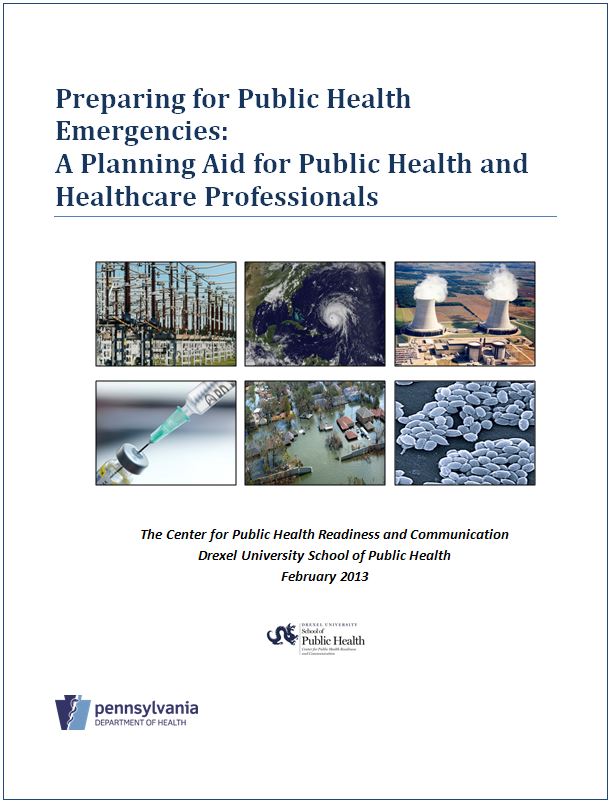Preparing for Public Health Emergencies: A Planning Aid for Public Health and Healthcare Professionals
 The CPHRC has developed a Planning Aid to serve as a reference guide for local and state health departments to use before, during, and after disasters. By researching existing local and state hazard mitigation plans and vulnerability analyses for the Philadelphia Metropolitan Statistical Area, the CPHRC was able to compile a list of nineteen hazards most likely to affect southeastern Pennsylvania. These hazards are broken down into three categories: natural, accidental/industrial, and adversarial/intentional. The Planning Aid outlines the potential consequences of these hazards that can be expected in terms of human, healthcare, community, and public health service impacts, as well as preparedness strategies for public health agency planners. Examples of public health consequences include types of expected illnesses and injuries (human impacts); numbers of persons seeking emergency department care (healthcare services impacts); utility outages and environmental contamination (community impacts); and surveillance and health communication efforts (public health service impacts). The descriptions listed under the human, healthcare, community, and public health service impacts for each hazard are meant to guide current and future planning efforts by encouraging agencies to prepare for indirect consequences of disasters. Additionally, the Planning Aid examines cross-cutting public health issues seen across multiple disasters, including communication failure, population displacement, supply disruption, transportation disruption, and workforce depletion. These are displayed in tabular form to allow public health personnel to quickly reference the causes, consequences, response measures, and preparedness strategies necessary for these issues.
The CPHRC has developed a Planning Aid to serve as a reference guide for local and state health departments to use before, during, and after disasters. By researching existing local and state hazard mitigation plans and vulnerability analyses for the Philadelphia Metropolitan Statistical Area, the CPHRC was able to compile a list of nineteen hazards most likely to affect southeastern Pennsylvania. These hazards are broken down into three categories: natural, accidental/industrial, and adversarial/intentional. The Planning Aid outlines the potential consequences of these hazards that can be expected in terms of human, healthcare, community, and public health service impacts, as well as preparedness strategies for public health agency planners. Examples of public health consequences include types of expected illnesses and injuries (human impacts); numbers of persons seeking emergency department care (healthcare services impacts); utility outages and environmental contamination (community impacts); and surveillance and health communication efforts (public health service impacts). The descriptions listed under the human, healthcare, community, and public health service impacts for each hazard are meant to guide current and future planning efforts by encouraging agencies to prepare for indirect consequences of disasters. Additionally, the Planning Aid examines cross-cutting public health issues seen across multiple disasters, including communication failure, population displacement, supply disruption, transportation disruption, and workforce depletion. These are displayed in tabular form to allow public health personnel to quickly reference the causes, consequences, response measures, and preparedness strategies necessary for these issues.
CPHRC staff worked collaboratively with the Pennsylvania Department of Health to develop the Planning Aid. The Pennsylvania Department of Health used funding from the CDC’s Risk-based Funding Pilot Project to contract with the CPHRC to complete the Planning Aid.
Click here to download the Planning Aid [PDF]